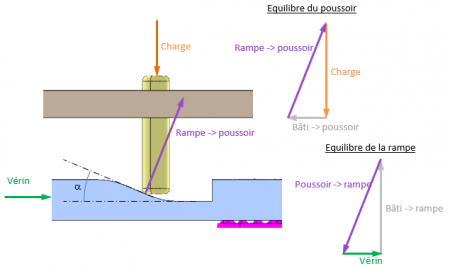Hi all.
I want to put two supports (aluminum) in motion in relation to each other. The goal is to put them in contact or not. The rest position of the system is "both supports apart" and the distance between the two supports is about 8 minutes max when the system is at rest and in contact when the system is at work. On my 3D, the blue part is fixed and the beige is mobile.
To do this, I put 4 axes associated with brass bearings to allow this movement. These pins have a large diameter to keep the parallelism of the two supports. Slots are provided for return springs that will move the supports apart when the system is at rest, these springs are optional depending on the actuator used.
Namely that I only have an electrical source to automate the movement, so the movement will be carried out by an electric actuator. The effort to put the supports in contact is 13 Kg + the weight of the support, for this I plan to use an electric actuator which provides a force of 18kg.
Before thinking about the 3D provided in this thread, I made on an aluminum profile model with axes and bearings bought on the net, but with a displacement of 35 mm instead of the current 8 mm. After hours of adjustments to align everything, the tests on the movement were far from optimal, so I come to try to find help.
I am looking for your advice to set up the solution, the most suitable or functional for this trip.
And here are my questions:
Do you think that the structure imagined on the 3D is correct?
During my 1stattempts , I used two cylinders of identical reference (thinking that they would have an identical speed of movement too), to push the support from the center of the two opposite widths so as close as possible to the axes. As these cylinders did not have exactly the same speed of travel, after about 20 mm the displaced support was no longer perpendicular to the axes and the system jammed. I changed these two cylinders by another one (with 2 times more force) and I tried with this single cylinder to push the support from its center, the operation was better but still not enough to have a perfect and above all repetitive movement.
My conclusions about these problems are:
As the structure is made of aluminium profile, it is almost impossible to be sure that the thrust is applied to the centre of the support to be moved. I guess the efforts were not perfectly distributed, moreover the movement was jerky as if to "overcome" constraints on the axes.
The actuator attachments were also fixed at both of these ends, perhaps the actuator was also adding stress to the axes during travel.
I imagine solving these problems:
By reducing the travel stroke. 8 mm instead of the starting 35 mm (the stroke of my cylinder is 40 mm)
By using the electric actuator in "single acting" mode (with return springs), so the actuator only pushes and it is not attached to the support to be moved, there should be less stress.
What do you think of the push point in the center of the support, so far from the axes? Is there a problem to consider?
What do you think?
I had also imagined a kind of camshaft moved by the electric cylinder and the cams moving the aluminum support, but this is beyond my capabilities and will increase the number of parts to be made.
Solenoids (next to each axis) could also have done the trick for this short trip, but with the same risk that they don't move at the same time.
If you have any ideas to propose to me, remarks on my structure.. I'm a taker for everything!!
Thank you in advance.
assem1.igs

